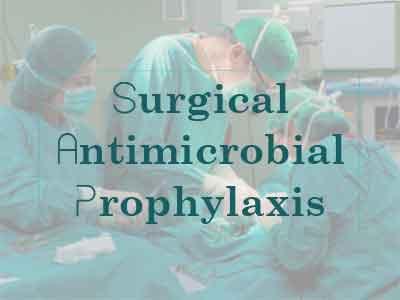- Home
- Editorial
- News
- Practice Guidelines
- Anesthesiology Guidelines
- Cancer Guidelines
- Cardiac Sciences Guidelines
- Critical Care Guidelines
- Dentistry Guidelines
- Dermatology Guidelines
- Diabetes and Endo Guidelines
- Diagnostics Guidelines
- ENT Guidelines
- Featured Practice Guidelines
- Gastroenterology Guidelines
- Geriatrics Guidelines
- Medicine Guidelines
- Nephrology Guidelines
- Neurosciences Guidelines
- Obs and Gynae Guidelines
- Ophthalmology Guidelines
- Orthopaedics Guidelines
- Paediatrics Guidelines
- Psychiatry Guidelines
- Pulmonology Guidelines
- Radiology Guidelines
- Surgery Guidelines
- Urology Guidelines
Benefits of Post operative antimicrobial prophylaxis limited to first 24 hours: JAMA

USA: The benefits of antimicrobial prophylaxis are limited to the first 24 hours postoperatively. A recent study published in the journal JAMA Surgery has found that increasing the duration of antimicrobial prophylaxis after a major surgery increases the risk for Antimicrobial resistance, Clostridium difficile infection and acute kidney injury (AKI) in a duration-dependent fashion. Extended duration did not lead to an additional reduction in surgical site infection (SSI).
This suggests that the risk of adverse events increases with each additional day of antimicrobial exposure.
Antimicrobial prophylaxis is beneficial up to 24 hours after surgery for the prevention of infection complications. However not much is known about the adverse effects of continuing antimicrobial prophylaxis after skin closure. Westyn Branch-Elliman, Department of Medicine, VA Boston Healthcare System, Boston, Massachusetts, and colleagues conducted the study to characterize the association of type and duration of prophylaxis with surgical site infection (SSI), acute kidney injury (AKI), and C difficile infection.
For the purpose, the researchers examined data from patients in the national Veterans Affairs health care system following cardiac, orthopaedic total joint replacement, colorectal, and vascular procedures from October 2008 to October 2013. Outcomes included 30-day surgical site infection, the 7-day incidence of AKI, and 90-day incidence of C. difficile infection.
Overall, about 79,000 patients underwent surgical procedures, about half of which were orthopaedic procedures, while a little over a quarter were cardiac procedures. Nearly all patients were men, and the mean age was about 65. About 27% of patients had diabetes and almost 30% were smokers.
Also Read: GOI Guidelines For Surgical Antimicrobial Prophylaxis
They found that:
- Among 79 058 surgical procedures in the cohort, all had SSI and C difficile outcome data available; 71 344 (90.2%) had AKI outcome data.
- After stratification by type of surgery and adjustment for age, sex, race, diabetes, smoking, American Society of Anesthesiologists score greater than 2, methicillin-resistant Staphylococcus aureus colonization, mupirocin, type of prophylaxis, and facility factors, SSI was not associated with duration of prophylaxis.
- After adjustment, there was no association between surgical skin infection risk factors and duration of antibiotic prophylaxis. But there were significant increases in the odds of AKI with antibiotic prophylaxis following non-cardiac procedures:
- 24 to <48 hours of antimicrobial prophylaxis: adjusted OR 1.31, 95% CI 1.21-1.42
- 48 to <72 hours: aOR 1.72, 95% CI 1.47-2.01
- ≥72 hours: aOR 1.79, 95% CI 1.27-2.53
- The risk of postoperative C difficile infection demonstrated a similar duration-dependent association (24-<48 hours: aOR 1.08; 95% CI, 0.89-1.31; 48-<72 hours: aOR, 2.43; 95% CI, 1.80-3.27; ≥72 hours: aOR, 3.65; 95% CI, 2.40-5.53).
- The unadjusted numbers needed to harm for AKI after 24 to less than 48 hours, 48 to less than 72 hours, and 72 hours or more of postoperative prophylaxis were 9, 6, and 4, respectively; and 2000, 90, and 50 for C difficile infection, respectively.
- Vancomycin (alone or in combination) was also associated with increased odds of AKI in both cardiac and non-cardiac procedures.
Also Read: ICMR Antimicrobial guidelines for prophylaxis and treatment of Surgical Site Infections
"Surgical site infections (SSIs) are among the most common and costly healthcare-associated infections. While the goal of perioperative antimicrobial prophylaxis is to prevent SSIs, antibiotic misuse is widespread and can have deleterious effects. The unintended consequences of prolonged therapy include drug toxicity, the emergence of Clostridium difficile infections, and antimicrobial resistance," Mary Hawn, and Lisa Marie Knowlton, of Stanford University in California, wrote in an accompanying editorial.
"These findings highlight the notion that everyday matters and suggest that stewardship efforts to limit the duration of prophylaxis have the potential to reduce adverse events without increasing SSI," concluded the study authors.

Disclaimer: This site is primarily intended for healthcare professionals. Any content/information on this website does not replace the advice of medical and/or health professionals and should not be construed as medical/diagnostic advice/endorsement or prescription. Use of this site is subject to our terms of use, privacy policy, advertisement policy. © 2020 Minerva Medical Treatment Pvt Ltd